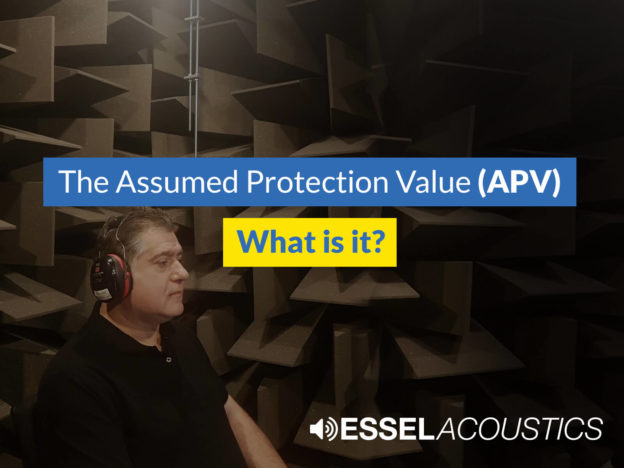
The Assumed Protection Value (APV) of a hearing protector – what is it? How is it derived, and how does it relate to the ‘real world’?
You may have seen the APV printed on the packaging of hearing protectors and probably thought “what does this actually mean?”
The APV data is typically represented as shown in the table below:
| Frequency (Hz) | 63 | 125 | 250 | 500 | 1k | 2k | 4k | 8k |
| Mean attenuation (dB) | 14.1 | 11.6 | 18.7 | 27.5 | 32.9 | 33.6 | 36.1 | 35.8 |
| Standard deviation (dB) | 4.0 | 4.3 | 3.6 | 2.5 | 2.7 | 3.4 | 3.0 | 3.8 |
| APV (dB) | 10.1 | 7.3 | 15.1 | 25.0 | 30.2 | 30.2 | 33.1 | 32.0 |
The APV is the minimum attenuation protection provided by the hearing protector (in each of the octave frequency bands) for a percentage of the population. It is the APV that is used to predict the noise levels ‘in the ear’ with the hearing protector in place.
So, the noise level ‘in the ear’ (dB) = the noise level external to the hearing protector (dB) – APV(dB), in each of the octave frequency bands.
NB: to arrive at the overall noise level ‘in the ear’ (in dBA), for assessing the possibility of hearing damage, you’ll need to convert each of the spectral band noise levels into equivalent ‘A-weighted noise levels, and logarithmically sum them all up. That’s another exercise.
Deriving the APV

The APV is derived from the mean attenuation obtained of a hearing protector tested under controlled conditions in a certified laboratory. The test, in accordance with an EN352 standard, follows a subjective based method where the hearing threshold of subjects are measured with and without the hearing protection in place. The noise attenuation is simply the difference between these two measurements.
The test conditions include trained and motivated wearers (receiving supervision, if required) fitting the hearing protection in accordance with the manufacturer’s instructions. This test method provides the best assurance that the attenuation data obtained will be repeatable.
The test data is collected across a combination of a specified number of wearers and hearing protectors, and by processing this data, the mean value of the attenuation and the standard deviation (which depends on the spread of the data) may be calculated at each of the frequency bands in the above table for the hearing protector type under test. By definition, we have:
APV (dB) = mean attenuation (dB) – p x standard deviation (dB)
where p is a constant.
With p = 1, which is often chosen to be the case (in UK and Europe), statistically, 84% of the population (if tested under laboratory conditions) will be assumed to achieve a minimum attenuation which is the APV. Therefore 16% of the population will NOT achieve the minimum attenuation. So not everyone will be equally protected.
The statistical spread of test results in the laboratory is down to, amongst other things, anthropometric differences in head shapes between the test subjects and any manufacturer’s tolerances across the build of the hearing protectors tested.
APV and the ‘real world’
In the ‘real world’, however, user conditions are highly uncontrolled compared to a laboratory type environment, due to factors such as incorrect fitting, poor maintenance, the wearing of spectacles and jewelry, plus interference by other personal protective equipment. For these reasons, it’s highly likely that the manufacturers’ specified APV performance will suffer some degree of degradation. The HSE recommends that a derating factor of 4dB be applied to your calculations (i.e. add 4dB to the result) when predicting the noise level at the ear with the hearing protector in place.
Although it is highly unlikely that the APV performance of a hearing protector can be replicated in the ‘real world’, with the provision of instruction and training (which is a legal requirement in high risk noisy areas), staff can be taught how to properly wear, maintain and look after hearing protection. The outcome would more than likely maximise the effectiveness of the hearing protection and therefore minimise the chances of noise induced hearing damage.
Confused? Then leave it to us. Essel Acoustics has the skills, experience, and qualifications to correctly prescribe appropriate hearing protection. We can also provide training in noise awareness and instruction in the correct use of hearing protection at both, operator and supervisor/manager levels.
See www.esselacoustics.com

